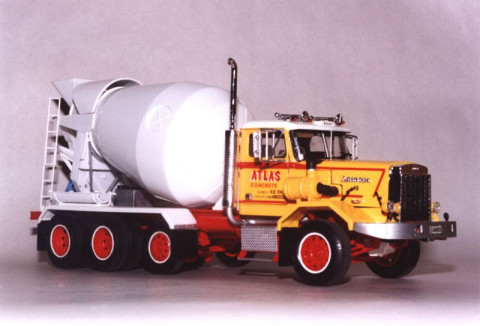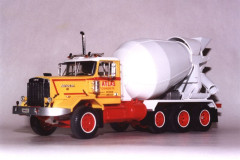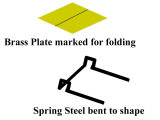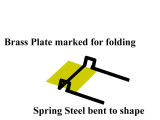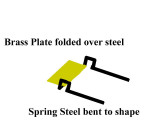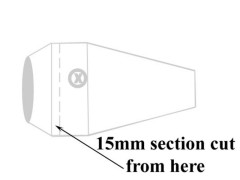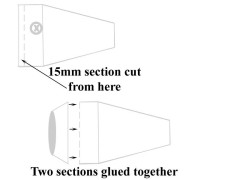Built by Warren Piesse, 2002.
Click on any photo to see a larger version
Inspiration:
The inspiration for this project first came from the photos and accompanying article in "New Zealand Trucking Magazine" (May 1988, pages 40-43) of trucks belonging to Atlas Concrete of Kumeu and Takapuna.
For more information on the trucks I purchased, from Ben Uncles a keen truck photographer for many years in the North Island, reprints of photos originally taken when the trucks were working in the 1980s.
In 1984 Atlas bought, second hand from a large project in Sri Lanka, eleven of these 1982 Autocar trucks. The company converted them in New Zealand for use as dumpers and concrete mixers and for low bed work in the North Island.
|
The AMT Autocar DC Dump truck kit No. T817 was one of the first model truck kits I built around the time it was first released in 1972. AMT was sold to Matchbox in the 1970s and they later re-issued the kit as PK 8403. It was this latter kit that I used for the basis of the model together with the ERTL Mack DM800 Rex Mixer No. 8019 from the same era which I used to supply the bowl and other extras. I have had both kits sitting "surplus" for some time. |
|
Construction:
The kit was converted to right hand drive by modifications to the cab, chassis and dash. The chassis had the steering box moved to the right hand side and during the construction of the chassis I increased the length of the chassis rails to accommodate an extra tag (lifting) axle that was added ahead of the rear drive axles. Different wheels were added all round the truck from the "spares box". The dash was modified so that the dials and steering wheel were moved to the right hand side.
The new right hand side "driver's" door was cut open with a razor-saw. A hinge, made from flat brass and spring steel, was fitted so that the door could be opened and closed (see diagrams). New slam-lock type door handles were also fitted to the cab from the "spares" box.
To make the hinge cut flat brass sheet to the dimensions required. Bend spring steel with long nose pliers to the shape you need. Fold brass sheet in half around the spring steel. Attach brass to the cab and the spring steel to the door using five-minute resin glue.
The bowl from the ERTL kit was too large for the intended model, so a 15mm section was cut from the bowl's length at the front of the "flat" section (with the big X). The two sections were then glued back together, giving a mixer bowl more suited to the scale and size of the intended vehicle.
The kit's rear mud guards had the ribs sanded off and were fitted to the rear chassis. The front chassis was extended to accommodate the hydraulic pump, in front of the grill and the gap between the front mudguards and the bumper was filled with flat panels either side. The front bumper was extended to curve around the entire front of the truck.
The kit's bowl ladder was repositioned to the rear of the truck and another section of ladder was added to extend its reach. A tap was scratch-built and hose was added using telephone wire (blue for effect). These were fitted to the rear of the vehicle.
Painting:
The model was painted with spray cans using an undercoat of Dupli-colour Sandable Primer for Enamels and Lacquers in grey for the cab and bowl. Then the cab and bowl were sprayed with Dupli-colour Lacquer in gloss white. These spray cans have different spray nozzles that produce a spray pattern similar to that of a full size spray gun, that is it sprays in an oval type pattern rather than a round, circular pattern.
The roof was then masked off to leave it white and the rest of the cab was sprayed with Plastikote Premium Water based enamel #595 Marigold Yellow as this seemed the best colour match from all the photos. This can be a risky move but I had no choice.
The chassis was then sprayed using Holts Dupli-colour Auto Spray Lacquer DSC44 Spanish Red – a Mitsubishi colour. This type of paint also has the oval spray pattern nozzles. The wheel hubs were sprayed gloss white and the rims, next tot t he rubber tyres, were then sprayed the same colour red as the chassis.
The detail of the sign-writing was achieved using different sizes of dry Lettraset characters applied to clear water-slide transfer.
Reason for building:
This model was built so that I had a new model to exhibit at the National Model Truck Competitions that were held in Blenheim over Easter, 2002. This was the very first time the competitions had been held outside the North Island since the inception of the competition in the late 1970s.
Building was spread over a period of about six months with lots of weekend hours needed to finish it in time. Although not an exact replica of the vehicle Atlas used, the model is a good representation of it and it now sits in my model cabinet alongside the other, mainly New Zealand, "rigs" I have in my collection. This collection consists of trucks I have seen on the New Zealand roads and decided to build models of.
If you are interested in seeing how one of these trucks looks now, see New Zealand Trucking Magazine, April 2002, page 29.
February, 2003
